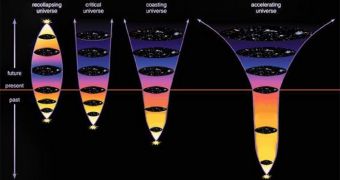One of the most remarkable, yet unproven, tenants of the currently-accepted model of the Universe is that the entire Cosmos is geometrically flat. This may be a consequence of the fact that the entire thing is expanding at an ever-accelerated rate, but thus far no one has produced clear evidence of this.
When astronomers first established that this flatness was a reality, they were extremely surprised. In a system that expands at an accelerated pace, such a finding is remarkable. Yet, our current models can only operate if this is indeed the case.
In fact, there are three key scenarios describing the possible shapes and fates of the Universe. Each of them stems from a different interpretation of Albert Einstein's field equations. Calculations known as Friedmann equations are generally used to analyze the shape and destiny of the Universe.
The first scenario calls for the existence of a closed Universe, in which space time takes on a hyper-spherical geometrical shape. This is caused by the fact that everything contained within has a tremendously large density.
If this scenarios is valid, then we could expect that the Cosmos will literally implode. This means that it will collapse under its own weight, similar to how the core of a massive star turns into a black hole.
The second scenario details an open Universe that does not feature the ability to shape spacetime upon itself. As such, the end result is a saddle-shaped product that is destined to expand forever.
In the third and final scenario, the Universal density has just the right amount, but no one can predict its future with any degree of certainty. This is why cosmologists find it so hard to describe the ultimate fate of the Cosmos, Universe Today reports.
When these ideas were first proposed, researcher took to analyzing universal density in order to verify them. They learned that the Cosmos featured a density level of 0.2 atoms per cubic meter, whereas 5 atoms per cubic meter were needed to support the flat Universe theory.
Researchers therefore hit an obstacle in their studies, but eventually the necessary technology was developed to observe the geometry of the Universe directly. This was made possible by spacecraft such as the NASA Wilkinson Microwave Anisotropy Probe (WMAP).

 14 DAY TRIAL //
14 DAY TRIAL //